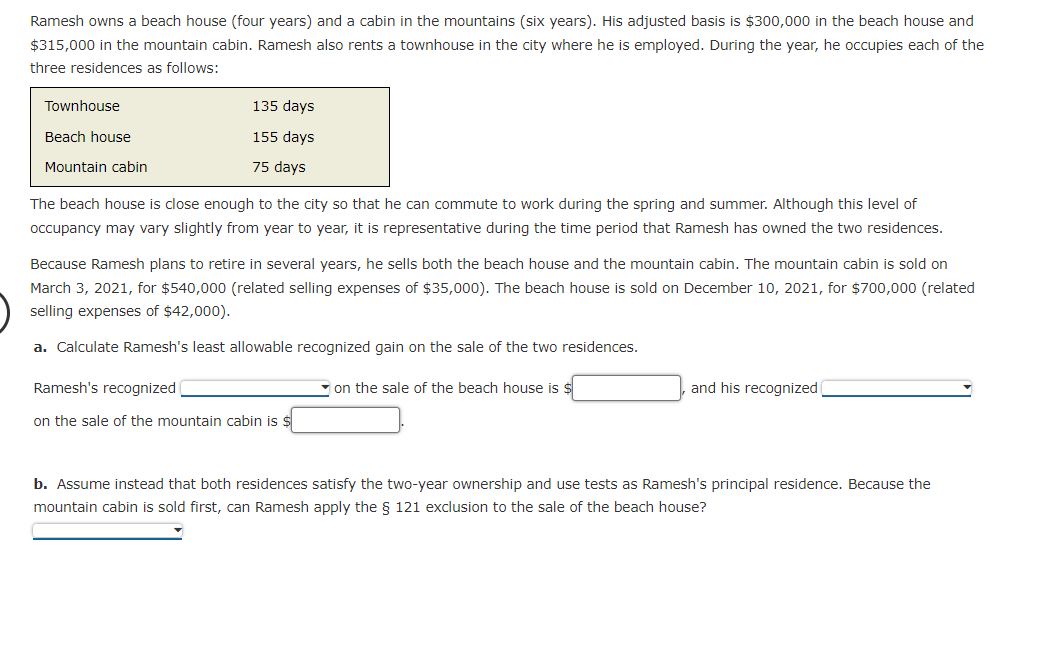Ramesh owns a beach house (four years) and a cabin in the mountains (six years). His adjusted basis is $300,000 in the beach house and $315,000 in the mountain cabin. Ramesh also rents a townhouse in the city where he is employed. During the year, he occupies each of the three residences as follows: Townhouse 135 days Beach house 155 days Mountain cabin 75 days The beach house is close enough to the city so that he can commute to work during the spring and summer. Although this level of occupancy may vary slightly from year to year, it is representative during the time period that Ramesh has owned the two residences. Because Ramesh plans to retire in several years, he sells both the beach house and the mountain cabin. The mountain cabin is sold on March 3, 2021, for $540,000 (related selling expenses of $35,000). The beach house is sold on December 10, 2021, for $700,000 (related selling expenses of $42,000). a. Calculate Ramesh's least allowable recognized gain on the sale of the two residences. Ramesh's recognized - on the sale of the beach house is s and his recognized on the sale of the mountain cabin is s b. Assume instead that both residences satisfy the two-year ownership and use tests as Ramesh's principal residence. Because the mountain cabin is sold first, can Ramesh apply the § 121 exclusion to the sale of the beach house?
Ramesh owns a beach house (four years) and a cabin in the mountains (six years). His adjusted basis is $300,000 in the beach house and $315,000 in the mountain cabin. Ramesh also rents a townhouse in the city where he is employed. During the year, he occupies each of the three residences as follows: Townhouse 135 days Beach house 155 days Mountain cabin 75 days The beach house is close enough to the city so that he can commute to work during the spring and summer. Although this level of occupancy may vary slightly from year to year, it is representative during the time period that Ramesh has owned the two residences. Because Ramesh plans to retire in several years, he sells both the beach house and the mountain cabin. The mountain cabin is sold on March 3, 2021, for $540,000 (related selling expenses of $35,000). The beach house is sold on December 10, 2021, for $700,000 (related selling expenses of $42,000). a. Calculate Ramesh's least allowable recognized gain on the sale of the two residences. Ramesh's recognized - on the sale of the beach house is s and his recognized on the sale of the mountain cabin is s b. Assume instead that both residences satisfy the two-year ownership and use tests as Ramesh's principal residence. Because the mountain cabin is sold first, can Ramesh apply the § 121 exclusion to the sale of the beach house?
Chapter12: Alternative Minimum Tax
Section: Chapter Questions
Problem 42P
Related questions
Question
The answer for:
a. Ramesh's recognized should be either ( gain or loss)
and his recognized (gain or loss) on the sale......
b. one of this three choices
Yes, But only if he forgoes the &121 exclision on the montain cabin
Yes, the amount he doesn't use on the mountain cabin can be applied to the beach house
No, the &121 exclusion must be applied to the residence he sells first
Also, I need all to be answered please

Transcribed Image Text:Ramesh owns a beach house (four years) and a cabin in the mountains (six years). His adjusted basis is $300,000 in the beach house and
$315,000 in the mountain cabin. Ramesh also rents a townhouse in the city where he is employed. During the year, he occupies each of the
three residences as follows:
Townhouse
135 days
Beach house
155 days
Mountain cabin
75 days
The beach house is close enough to the city so that he can commute to work during the spring and summer. Although this level of
occupancy may vary slightly from year to year, it is representative during the time period that Ramesh has owned the two residences.
Because Ramesh plans to retire in several years, he sells both the beach house and the mountain cabin. The mountain cabin is sold on
March 3, 2021, for $540,000 (related selling expenses of $35,000). The beach house is sold on December 10, 2021, for $700,000 (related
selling expenses of $42,000).
a. Calculate Ramesh's least allowable recognized gain on the sale of the two residences.
Ramesh's recognized
v on the sale of the beach house is $
and his recognized
on the sale of the mountain cabin is $
b. Assume instead that both residences satisfy the two-year ownership and use tests as Ramesh's principal residence. Because the
mountain cabin is sold first, can Ramesh apply the & 121 exclusion to the sale of the beach house?
Expert Solution
This question has been solved!
Explore an expertly crafted, step-by-step solution for a thorough understanding of key concepts.
This is a popular solution!
Trending now
This is a popular solution!
Step by step
Solved in 2 steps with 2 images

Knowledge Booster
Learn more about
Need a deep-dive on the concept behind this application? Look no further. Learn more about this topic, accounting and related others by exploring similar questions and additional content below.Recommended textbooks for you







Individual Income Taxes
Accounting
ISBN:
9780357109731
Author:
Hoffman
Publisher:
CENGAGE LEARNING - CONSIGNMENT

